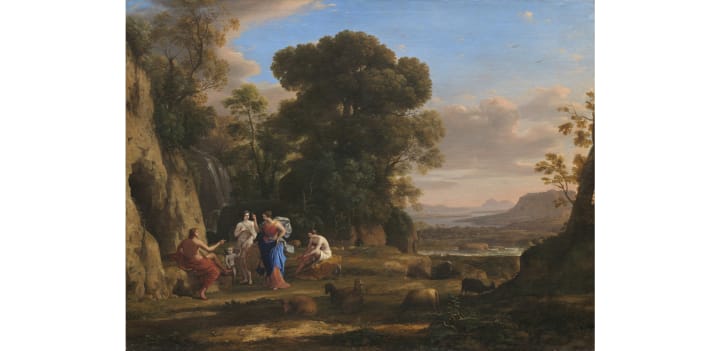Claude Lorrain and his classical landscapes
His paintings inspired many sons of noblemen to undertake the Grand Tour

Claude Gelée (c. 1604/5 to 1682) acquired the name Lorrain from his birthplace in eastern France, although he spent virtually all his life after 1627 in Rome. He specialised in landscape painting, being fascinated by the scenery and ruins in the countryside surrounding Rome and also being inspired by the quality of light in that part of Italy. He developed a means of including the sun as the direct source of light in his paintings, thus sending foreground and middle-distance objects into sharp relief. His method of composition was to use sketchbooks on his many trips into the countryside and to build his studio paintings around these sketches, many of which were highly detailed.
Claude introduced classical themes into his paintings from the late 1630s onwards, by painting figures from mythology or the Bible to add focus or emotional force to his landscapes. They were therefore additions to landscapes, as opposed to being direct portrayals of mythical stories set against a natural background.
However, his style gradually developed towards a more idealized view of nature and his choice of subject matter also showed a growing empathy with the ancient world. Later in life (he continued to paint to an advanced age) his work acquired a heroic or epic quality in which the landscape became more closely involved with the story of the characters being portrayed. However, Claude never went as far down this road as his contemporary Nicolas Poussin, for whom the figures were always dominant and the landscape served to add emotional emphasis. Claude was primarily interested in the scenery and atmospheric effects, and the figures, even when relatively large, never held pride of place in the overall composition.
Claude Lorrain’s landscapes, whether based on classical themes or not, often have a sense of mystery about them. The actual scenes, being classical in the sense that they portray the Italian countryside, either in reality or as half-imagined reconstructions, are certainly beautiful and are seen in a highly romantic light. Their distribution about Europe in the 18th century, being bought by many aristocrats and landed gentry, encouraged rich young men to undertake the “Grand Tour” to see the remains of the classical world for themselves. The paintings also inspired the construction of reproduction classical landscapes to surround the great houses that were built in 18th century England, complete with mock-Roman temples and follies. Many of these survive to the present day, such that glimpses of Claude Lorrain’s romantic classical vision can still be seen in places such as Stourhead in Wiltshire.
Landscape with the Judgement of Paris

Claude’s first known work with a mythological theme was “Landscape with the Judgement of Paris” that dates from before 1640. This was a theme that Claude revisited on several occasions, one example being the painting now exhibited in Washington’s National Gallery of Art and dated 1645. A notable feature of this latter canvas, confirming the point made above, is that it is precisely as named, a landscape first and the Judgement of Paris second. The eye is taken to a distant prospect of a sea, islands and cliffs, guided by the perspective and the use of light, as well as the framing of rocks and high trees. To the left of the canvas, in the near foreground, are the figures of Paris and the three goddesses that, between them, occupy no more than 10% of the entire canvas and are seemingly there merely to add interest to a landscape.
Landscape with Aeneas at Delos

A later example of Claude’s use of classical themes, that can be seen in London’s National Gallery, is his “Landscape with Aeneas at Delos”. This is one of six works that Claude painted towards the end of his life on subjects from Virgil (another regular source of inspiration was Ovid’s Metamorphoses). In this example, the characters of Aeneas, Anchises and Ascanius are being greeted by the king of Delos who points to a massive tree that was part of the story of Apollo and Diana, the island being sacred to them. Again, the figures are not the main focus of the painting, but they are at least linked to it as opposed to being purely incidental. One of the buildings in the painting, doubling as the Temple of Apollo, is the Pantheon at Rome, as sketched by the artist and transposed to a mythological context. This was a device frequently used by Claude, such that many familiar landmarks from the environs of Rome ended up in unexpected places.
The Enchanted Castle

Also in London's National Gallery, and one of Claude’s Lorrain’s best-known works, is “The Enchanted Castle”, which is properly titled “Landscape with Psyche at the Palace of Cupid”, the more familiar title only being given to it in 1782, with the painting itself dating from 1664. This painting is believed to have inspired John Keats to write his “Ode to a Nightingale”, having been impressed by the sense of melancholy and loss that it conveys. The scene is of Psyche sitting alone and looking towards the castle of Cupid that occupies the centre of the canvas. Cupid has abandoned her after she has broken his command not to look at him after dark. The castle itself looks to be an imaginative combination of building styles, incorporating classical elements with others that are contemporaneous with the artist’s time. The main emphasis, as ever with Claude Lorrain, is on the effect of sunlight and shadow. The sun appears to be low in the sky to the rear of the castle, so that the landscape on either side is bathed in evening light but the foreground, where Psyche sits, is thrown into shade. This heightens the emotional impact of the painting, in a way that earlier paintings by the artist tended not to do.
About the Creator
John Welford
I am a retired librarian, having spent most of my career in academic and industrial libraries.
I write on a number of subjects and also write stories as a member of the "Hinckley Scribblers".






Comments
There are no comments for this story
Be the first to respond and start the conversation.